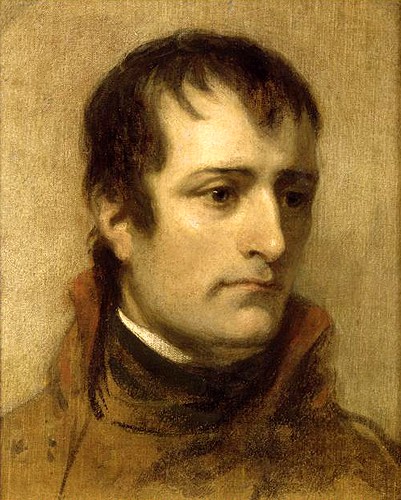One of the consequences of the Peace of Amiens in 1802 was that it allowed a number of English to cross over the Channel and visit France again. Like many others, Thomas Erskine (1750-1823) made this journey. He was the third son of the Count of Buchan as well as the first Lord Erskine and a well-known jurist. He was also a great admirer of Napoleon and owed his visit to Malmaison to Josephine. It is Erskine who commissioned Thomas Phillips (1770-1845) to paint the portrait of the First Consul. Phillips was a renowned portrait-artist and was later elected associate of the Royal Academy (1804) and then full member (1808). Amongst the most impressive works by the artist are the portraits of Lord Byron, including the famous Lord Byron in Albanian Dress (completed in 1813, and of which an 1835 copy exists in the National Portrait Gallery), and the portrait of Arthur Wellesley, Duke of Wellington (1814).
The painting commissioned by Lord Erskine was never finished. Depicted is Napoleon Bonaparte, then 33 years old, in his red Consul uniform, barely sketched, with a black cravate over a high-collar. Everything about the painting is in contrast to the energetic, visionary hero, full of ambition and self-assurance, that is portrayed in the official paintings of David, Gros and Ingrès and which were completed around the same time. Phillips' brushstrokes are lively and the model strikes an atypical pose, the framing tight in this bust portrait. Napoleon gazes sadly to one side, his complexion is sickly, and the air of melancholy is emphasised by the pinched lips and a slight grimace. In 1802, Bonaparte was enjoying a period of great popularity. The Consulate was at its apogee and the “French Washington” could seriously consider the possibility of becoming a “crowned Washington”, as Napoleon later described himself on the island of St. Helena. Phillips' highly-romanticised portrait, far from any idealisation, appears even more surprising in this triumphant context. Private commissions like this often allowed the artists a greater liberty in the composition and depication of the subject.
Although Napoleon was almost systematic in his refusal to pose for paintings, he still maintained a strict control over the way his image was portrayed. This painting's very life-like air, something so often lacking in Napoleon's portraits, has two possible explanations. The most likely is that, just as Isabey took advantage of Napoleon's stroll through the gardens of Malmaison for his painting of the emperor, Phillips may have sketched Napoleon during a reception. However, the Musée Bonnat in Bayonne, where the painting is housed, suggests that the First Consul may have indeed posed for the artist, an extraordinary act considering Napoleon's usual reluctance to do so. In this eventuality, Josephine's involvement cannot be discounted.
This surprising work deserves to be considered alongside the other great unfinished portrait that exists in the collections: that of Napoleon by Girodet, from 1808.
Denis Carlier (Tr. & ed. H.D.W. and P.H.)
January 2009
Napoleon Bonaparte, First Consul
Artist(s) : PHILLIPS Thomas

- Date :
- 1802
- Technique :
- Oil on canvas
- Dimensions :
- H = 42 cm, L = 35 cm
- Place held :
- Bayonne, Musée Bonnat

